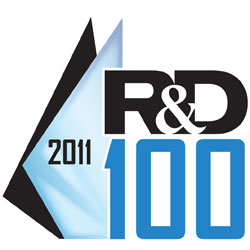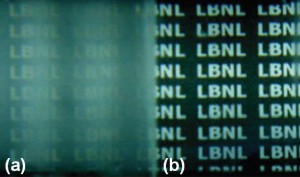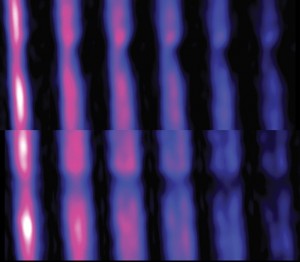 From the U.S. Department of Energy (DOE)’s Lawrence Berkeley National Laboratory (Berkeley Lab), a nanostructured anti-fogging technology for glass that out performs anything on the market today, and a new version of Magnetic Resonance Imaging (MRI) – called Magnetic Resonance Microarray Imaging – that delivers results a million times faster than conventional MRI, have both won 2011 R&D 100 awards, also known as the “Oscars of Innovation.”
From the U.S. Department of Energy (DOE)’s Lawrence Berkeley National Laboratory (Berkeley Lab), a nanostructured anti-fogging technology for glass that out performs anything on the market today, and a new version of Magnetic Resonance Imaging (MRI) – called Magnetic Resonance Microarray Imaging – that delivers results a million times faster than conventional MRI, have both won 2011 R&D 100 awards, also known as the “Oscars of Innovation.”
Presented by R&D Magazine, the R&D 100 Awards recognize the year’s 100 most significant proven technological advances. The two awards in 2011 bring the total of Berkeley Lab’s R&D 100 wins to 58, plus two Editors’ Choice Awards.
In all, DOE’s national laboratories and facilities won 36 R&D 100 Awards this year. In response, Energy Secretary Steven Chu released this statement.
“I want to congratulate this year’s R&D 100 award winners. The Department of Energy’s national laboratories and facilities are at the forefront of innovation, and it is gratifying to see their work recognized once again. The cutting-edge research and development done in our national labs and facilities is helping to meet our energy challenges, strengthen our national security and enhance our economic competitiveness.”

Glass slide placed in a freezer then exposed to humid air at room temperature. Fog formed on the uncoated portion of the slide (a) while portion (b), coated with superhydrophilic nanoparticles, remained fog free.
Invention of the “Nanostructured Antifogging Coating” technology was led by Samuel Mao, and members of his research group, Vasileia Zormpa and Xiaobo Chen, all with Berkeley Lab’s Energy and Environmental Technologies Division (EETD). This technology is designed to provide a durable, nontoxic, antifogging and self-cleaning coating for architectural glass, windshields, eyewear and solar panels.
The coating consists of nanoparticles made from superhydrophilic titanium dioxide. When applied to glass surfaces, these nanoparticles cause water droplets to collapse and flatten within fractions of a second. Water vapor, however, can infiltrate spaces formed by nanoparticle overhangs to dislodge dust and grime from the coated surface. This keeps the glass clean, a big water- saving factor for windows in commercial buildings. It could also be used to improve the efficiency of solar panels in dusty, desert environments.
“No chemical catalysts or UV radiation are required to activate the coating so therefore it works at night,” says Mao, who directs the Clean Energy Laboratory for EETD. “Also, because the coating is non-toxic, unlike some of its competitors, it can be used on dental mirrors and food wrap in refrigerated displays.”
Tests have shown Berkeley Lab’s Nanostructured Antifogging Coating to be more transparent, last much longer (years compared to months) and cost less than competing antifogging technologies.
Invention of the Magnetic Resonance Microarray Imaging (MMRI) technology was led by Alexander Pines, an internationally recognized leader in the development of Nuclear Magnetic Resonance (NMR) spectroscopy and its daughter technology MRI, and by Vikram Bajaj, a Project Scientist in Pines’ research group. Other principal investigators on the development team behind this work were David Wemmer and Matthew Francis. Pines, Bajaj and Francis are affiliated with Berkeley Lab’s Materials Sciences Division; Wemmer is with the Physical Biosciences Division.

MMRI of water flowing through a constricted microfluidic channel as a series of image ‘snapshots’ over a given time of flight.
MMRI combines remote instrumentation, JPEG-style image compression algorithms, and other key enhancements to image materials flowing through microfluidic “lab-on-a-chip” devices and zoom in on microscopic objects of particular interest with unprecedented spatial and time resolutions. Portable and magnet-free, MMRI technology can provide fast, on-site analyses of medical, environmental or industrial fluids. With its high degree of spatial resolution, it can quickly capture the results of hundreds or thousands of parallel assays on a single microfluidic chip.
“Our technology enables time-resolved imaging of multi-channel flow; dispenses with the need for large, expensive magnets for NMR analysis; is able to assay complex, unprocessed mixtures in one pass; and adds portability to NMR/MRI,” Bajaj says. “The cost of components for our MMRI technology is also far less than conventional NMR/MRI components.”
Berkeley Lab’s R&D 100 nominations are submitted through its Technology Transfer and Intellectual Property Management Department, which is headed by Cheryl Fragiadakis.
“This year’s winning Berkeley Lab technologies demonstrate our researchers’ dedication to real world applications and impacts,” Fragiadakis says. “I congratulate the research and staff who prepared the award entries. Being recognized by the R&D100 Awards is a welcome acknowledgement of their work.”
Lawrence Berkeley National Laboratory addresses the world’s most urgent scientific challenges by advancing sustainable energy, protecting human health, creating new materials, and revealing the origin and fate of the universe. Founded in 1931, Berkeley Lab’s scientific expertise has been recognized with 12 Nobel prizes. The University of California manages Berkeley Lab for the U.S. Department of Energy’s Office of Science. For more, visit www.lbl.gov.
Additional Information
To read the DOE press release on all of the national laboratory R&D 100 Awards go here http://www.energy.gov/news/releases.htm
For more about Berkeley Lab’s R&D 100 Awards visit the Website at http://www.lbl.gov/Tech-Transfer/success_stories/honors.html
For more about Berkeley Lab’s Technology Transfer and Intellectual Property Management Department
For more information about R&D Magazine’s R&D 100 Awards program visit the Website at http://www.rdmag.com/Awards/RD-100-Awards/R-D-100-Awards/